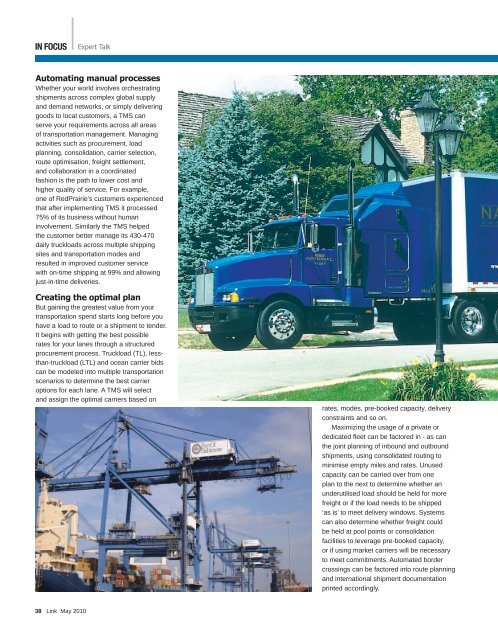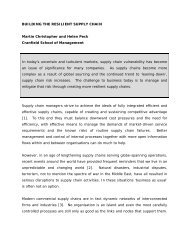Free to Download - SCLG
Free to Download - SCLG
Free to Download - SCLG
Create successful ePaper yourself
Turn your PDF publications into a flip-book with our unique Google optimized e-Paper software.
IN FOCUS<br />
Expert Talk<br />
Au<strong>to</strong>mating manual processes<br />
Whether your world involves orchestrating<br />
shipments across complex global supply<br />
and demand networks, or simply delivering<br />
goods <strong>to</strong> local cus<strong>to</strong>mers, a TMS can<br />
serve your requirements across all areas<br />
of transportation management. Managing<br />
activities such as procurement, load<br />
planning, consolidation, carrier selection,<br />
route optimisation, freight settlement,<br />
and collaboration in a coordinated<br />
fashion is the path <strong>to</strong> lower cost and<br />
higher quality of service. For example,<br />
one of RedPrairie’s cus<strong>to</strong>mers experienced<br />
that after implementing TMS it processed<br />
75% of its business without human<br />
involvement. Similarly the TMS helped<br />
the cus<strong>to</strong>mer better manage its 430-470<br />
daily truckloads across multiple shipping<br />
sites and transportation modes and<br />
resulted in improved cus<strong>to</strong>mer service<br />
with on-time shipping at 99% and allowing<br />
just-in-time deliveries.<br />
Creating the optimal plan<br />
But gaining the greatest value from your<br />
transportation spend starts long before you<br />
have a load <strong>to</strong> route or a shipment <strong>to</strong> tender.<br />
It begins with getting the best possible<br />
rates for your lanes through a structured<br />
procurement process. Truckload (TL), lessthan-truckload<br />
(LTL) and ocean carrier bids<br />
can be modeled in<strong>to</strong> multiple transportation<br />
scenarios <strong>to</strong> determine the best carrier<br />
options for each lane. A TMS will select<br />
and assign the optimal carriers based on<br />
rates, modes, pre-booked capacity, delivery<br />
constraints and so on.<br />
Maximizing the usage of a private or<br />
dedicated fl eet can be fac<strong>to</strong>red in - as can<br />
the joint planning of inbound and outbound<br />
shipments, using consolidated routing <strong>to</strong><br />
minimise empty miles and rates. Unused<br />
capacity can be carried over from one<br />
plan <strong>to</strong> the next <strong>to</strong> determine whether an<br />
underutilised load should be held for more<br />
freight or if the load needs <strong>to</strong> be shipped<br />
‘as is’ <strong>to</strong> meet delivery windows. Systems<br />
can also determine whether freight could<br />
be held at pool points or consolidation<br />
facilities <strong>to</strong> leverage pre-booked capacity,<br />
or if using market carriers will be necessary<br />
<strong>to</strong> meet commitments. Au<strong>to</strong>mated border<br />
crossings can be fac<strong>to</strong>red in<strong>to</strong> route planning<br />
and international shipment documentation<br />
printed accordingly.<br />
38 Link May 2010

















